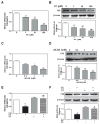Role of AMP-activated protein kinase α1 in 17α-ethinylestradiol-induced cholestasis in rats
- PMID: 27090119
- PMCID: PMC5069111
- DOI: 10.1007/s00204-016-1697-8
Role of AMP-activated protein kinase α1 in 17α-ethinylestradiol-induced cholestasis in rats
Abstract
Estrogen-induced cholestasis occurs in many women who are susceptible due to pregnancy or hormone replacement therapy for postmenopausal syndrome. 17α-Ethinylestradiol (EE), as a synthetic estrogen, has been widely used to study the underlying mechanisms of estrogen-induced cholestasis. Recent studies have also reported that liver kinase B1 (LKB1)-mediated activation of AMP-activated protein kinase (AMPK) plays a critical role in the regulation of canalicular network formation. However, the role of AMPK in EE-induced cholestasis remains to be determined. In this study, the effects of EE (1-100 µM) on AMPK activation and the expression of farnesoid X receptor (FXR) and hepatic bile acid transporters were examined in in vitro using 3D-cultured rat primary hepatocytes and in in vivo using rat cholestasis models. We also used specific chemical agonist and antagonist of AMPK, AMPK subunit-specific antibodies and lentiviral shRNAs for AMPKα1 and AMPKα2 to delineate the role of AMPK in EE-induced cholestasis and potential cellular mechanisms. We found that EE-induced phosphorylation of AMPKα1 via extracellular signal-regulated kinases-LKB1-mediated signaling pathways and subsequent nuclear translocation accounted for the down-regulation of FXR and bile acid transporters and disruption of bile acid homeostasis. Inhibition of AMPK activation using an AMPK antagonist Compound C (2 µM) or down-regulation of AMPKα1 using gene-specific shRNA attenuated EE-induced cholestasis both in in vitro and in in vivo. In conclusion, these results revealed that activation of cAMP-ERK-LKB1-AMPKα1 signaling pathway plays a critical role in EE-mediated dysregulation of the expression of FXR and bile acid transporters. AMPKα1 may represent an important therapeutic target for estrogen-induced cholestasis.
Keywords: AMPKα1; Bile acid transporters; Cholestasis; Estrogen; FXR.
Conflict of interest statement
The authors declare no competing financial interest.
Figures








References
-
- Barth A, Klinger G, Rost M. Influence of ethinyloestradiol propanolsulphonate on serum bile acids in healthy volunteers. Experimental and Toxicologic Pathology. 2003;54(5):381–386. - PubMed
-
- Crocenzi FA, Sanchez Pozzi EJ, Pellegrino JM, et al. Beneficial effects of silymarin on estrogen-induced cholestasis in the rat: a study in vivo and in isolated hepatocyte couplets. Hepatology. 2001;34(2):329–339. - PubMed
MeSH terms
Substances
Grants and funding
LinkOut - more resources
Full Text Sources
Other Literature Sources
Molecular Biology Databases
Miscellaneous

